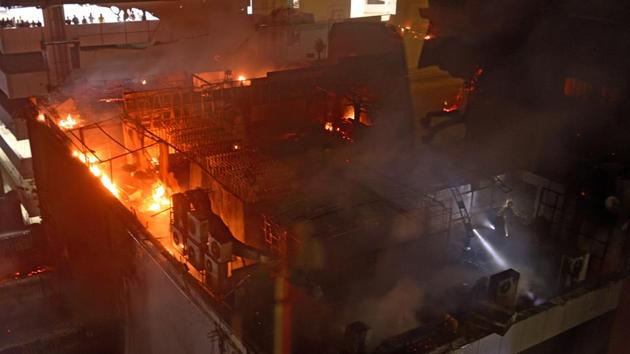Only 29% of south Mumbai fires get help in time: IIT-B study
Only 29% of south Mumbai fires get help in time: IIT-B study
Just one in three fire emergency calls in south Mumbai gets help from the fire brigade within eight minutes — the internationally accepted standard — according to an Indian Institute of Technology-Bombay (IIT-B) study, which also suggested ways to improve response time in crowded areas, and reduce casualties.

The team from IIT-B analysed Mumbai fire brigade’s data on response time to fire alarms, and found that only 29.25% of south Mumbai got help in eight minutes. Just 4.82% of the area got help in four minutes. Of the 17,000 calls the fire brigade gets in a year, 40% are from south Mumbai, an area that has seen some deadly fires in the past few years. Last week, a fire at Bhendi Bazaar killed two senior citizens; in December 2017, a fire in a pub at Kamala Mills claimed 14 lives; and the 2015 Kalbadevi fire killed four senior fire officers.
During the study, the team from IIT-Bombay’s Centre for Urban Sciences and Engineering (C-USE) also found that the location of the existing fire stations was based on the city’s layout in the early 20th century. The city has changed since — higher population density, more traffic, and an increase in the number of high-rise residential towers and commercial complexes with glass facades in south Mumbai — and researchers said the fire brigade may be finding it difficult to cope because of where fire stations are located.
Additionally, lack of credible information on the extent of the fire sometimes leads to inadequate deployment of resources that can result in a delay to control the fire.
The team then used artificial intelligence to develop a model that can predict suitable spots to set up mobile mini-fire stations, with the aim of reducing response time. The region covered by the study included Malabar Hill, Bhendi Bazaar, Colaba, Kamathipura, Byculla, Cumballa hill, Madanpura, Lower Parel, Parel, and Dhobighat — a total area of 41.76 sqkm serviced by six of the 34 fire stations in the entire city.
“The goal of fire-fighting is to provide service to maximum people in the minimum possible time. Today, it is not possible to build large fire stations because of a space crunch. Neither is it feasible to relocate a fire station due to the costs involved,” said Vaibhav Kumar, lead author and doctoral student, Centre for Urban Sciences and Engineering (C-USE), IIT-Bombay, who co-authored the study with professor Krithi Ramamritham.
With the idea of reducing the fire fighting team’s response time and maximising the area covered by a station, researchers have developed a dynamic model using artificial intelligence and mathematical techniques that can predict suitable locations for stationing mobile mini-fire stations based on vulnerability and density of an area in the south Mumbai region. In case of a fire, the model allows vehicles –fire tenders, rescue truck, water truck and ambulance – to be redistributed to maximize the coverage during different times of the day. When compared to the existing scenario, the model showed an approximate 10% to 15% increase in the area covered by various vehicles.
“Emergency response services in developing countries such as India face a dual challenge of lack of resources and selection of optimal locations to distribute the available resources. The exclusion of urban space details in the previous models also leads to unfeasible solutions,” said co-author Arnab Jana, assistant professor, C-USE. “Due to variations in the travel time and coverage demand throughout the day, a static location for a fire brigade is insufficient to provide good solutions.”
IIT-Bombay’s prediction model – it can be applied in current and the future scenarios– incorporated existing urban settlements in south Mumbai, and dynamic aspects comprising the demand for fire-fighting based on the number of calls every day, fire during different time periods of the day, hotspot areas, intensity of fires, travel time by the fire brigade to reach the destination, and area coverage.
Based on information from the fire brigade and urban space data, the study has proposed mini fire stations in high compact areas comprising informal settlements and slums, and large fire stations in high compact areas that include midrise and high rise buildings. “Our model determines optimal locations for fire stations and distribution of fire-fighting vehicles to achieve high coverage considering dynamic variations over various time periods. Placing mini fire stations in areas with high density urban sprawls provides quick access to the fire equipment facilities, and can also help in acquiring credible information. It can also prove to be economical if the resources need to be relocated over the short time,” read the study.
Stay updated with all the Breaking News and Latest News from Mumbai. Click here for comprehensive coverage of top Cities including Bengaluru, Delhi, Hyderabad, and more across India along with Stay informed on the latest happenings in World News.
Stay updated with all the Breaking News and Latest News from Mumbai. Click here for comprehensive coverage of top Cities including Bengaluru, Delhi, Hyderabad, and more across India along with Stay informed on the latest happenings in World News.





